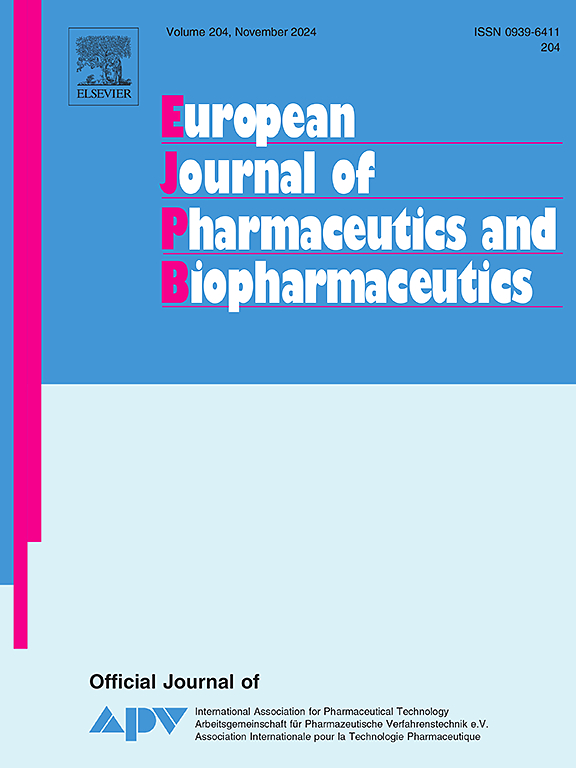六组氨酸-金属组装包封成纤维细胞生长因子21对脂多糖诱导急性肺损伤的影响。
IF 4.4
2区 医学
Q1 PHARMACOLOGY & PHARMACY
European Journal of Pharmaceutics and Biopharmaceutics
Pub Date : 2025-01-25
DOI:10.1016/j.ejpb.2025.114650
引用次数: 0
摘要
急性肺损伤(ALI)/急性呼吸窘迫综合征(ARDS)是目前缺乏有效药物治疗的一系列潜在致命疾病。最近的研究表明,成纤维细胞生长因子21 (FGF21)可能对ALI/ARDS有保护作用。然而,FGF21的临床应用受到其快速降解、靶向能力受限和众多不良反应的限制。为了解决这一挑战,该研究采用了一种被称为六组氨酸-金属组装体(HmA)的ph响应纳米颗粒递送系统来给药FGF21。HmA的包封效率(EE%)和负载能力(LCwt%)分别超过90 %和35 %,而HmA@FGF21纳米颗粒的平均尺寸为130 nm, PDI值约为0.28,zeta电位为24 mV。在动物实验中,无论是通过气道给药还是静脉给药,HmA@FGF21在脂多糖(LPS)诱导的肺损伤中显著优于单独给药的FGF21,包括减轻ALI的病理表现,降低BALF的干湿比、总蛋白浓度和总细胞计数。因此,这种治疗方法显示了将FGF21精确递送到肺部治疗ALI的希望,并可能为递送潜在药理药物以治疗其他肺部疾病提供一种新的、有效的方法。本文章由计算机程序翻译,如有差异,请以英文原文为准。

Hexahistidine-metal assembly encapsulated fibroblast growth factor 21 for lipopolysaccharide-induced acute lung injury
Acute lung injury (ALI)/acute respiratory distress syndrome (ARDS) represents a spectrum of potentially fatal conditions that currently lack effective drug treatment. Recent researches suggest that Fibroblast Growth Factor 21 (FGF21) may protect against ALI/ARDS. However, the clinical use of FGF21 is limited by its rapid degradation, restricted targeting capabilities, and numerous adverse effects. Addressing this challenge, the study employs a pH-responsive nanoparticle delivery system known as Hexahistidine-metal Assembly (HmA) for administering FGF21. The entrapment efficiency (EE%) and loading capacity (LCwt%) of HmA exceed 90 % and 35 %, respectively, while the HmA@FGF21 nanoparticles exhibit an average size of 130 nm, a PDI value of approximately 0.28, and a zeta potential of 24 mV. In animal experiments, HmA@FGF21 administered in lipopolysaccharide (LPS)-induced lung injury significantly exceed those of standalone FGF21, including mitigating the pathological manifestations and reducing the wet/dry ratio, total protein concentration, and overall cell count in BALF of ALI, whether administered via the airway or intravenously. This therapeutic approach therefore shows promise for precise delivery of FGF21 to the lungs to treat ALI, and may offer a novel, and efficient method for delivery of potential pharmacological agents to address other lung diseases.
求助全文
通过发布文献求助,成功后即可免费获取论文全文。
去求助
来源期刊
CiteScore
8.80
自引率
4.10%
发文量
211
审稿时长
36 days
期刊介绍:
The European Journal of Pharmaceutics and Biopharmaceutics provides a medium for the publication of novel, innovative and hypothesis-driven research from the areas of Pharmaceutics and Biopharmaceutics.
Topics covered include for example:
Design and development of drug delivery systems for pharmaceuticals and biopharmaceuticals (small molecules, proteins, nucleic acids)
Aspects of manufacturing process design
Biomedical aspects of drug product design
Strategies and formulations for controlled drug transport across biological barriers
Physicochemical aspects of drug product development
Novel excipients for drug product design
Drug delivery and controlled release systems for systemic and local applications
Nanomaterials for therapeutic and diagnostic purposes
Advanced therapy medicinal products
Medical devices supporting a distinct pharmacological effect.

 求助内容:
求助内容: 应助结果提醒方式:
应助结果提醒方式:


